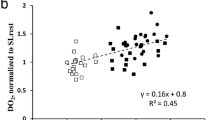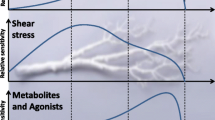Abstract
The optimum number of total capillaries in the whole human body was estimated from the analysis of the efficiency for oxygen (O2) transport in the vascular-tissue system. We used a tissue model composed of uniform spheres in which O2 diffuses from the capillary located at the centre of each sphere towards the surrounding tissue consuming O2 at a constant rate. The tissue mass supplied by a single capillary was estimated as the area of positive O2 concentration under a given condition of capillary flow and O2 consumption rate. Total tissue mass was determined as the function of the capillary numbern and the total blood flow. On the other hand, the energy cost required to maintain the vascular system withn terminals was assessed by using the minimum volume model (Kamiya and Togawa,Bull. math. Biophys. 34, 431–438, 1972). The efficiency of the entire vascular-tissue system was evaluated by calculating the ratio of total tissue mass/cost function. The result of the calculation using physiological data of cardiac output and O2 consumption for an average human adult during a heavy exercise revealed the maximum efficiency occurring at the capillary number 3.7×1010 which coincided well with its normal range of physiological estimates (3.2×1010–4.2×1010). We concluded that the entire vascular-tissue system is constructed so as to attain the highest efficiency in O2 transport at its maximum activity.
Similar content being viewed by others
Literature
Ando, J., H. Nomura and A. Kamiya. 1987. “The Effect of Fluid Shear Stress on the Migration and Proliferation of Cultured Endothelial Cells.”Microvasc. Res. 36, 62–70.
Chien, S. 1971. “Present State of Blood Rheology.” InHomodilusion, Theoretical Basis and Clinical Application, K. Messmer and H. Schmid-Schonbein (Eds). Basel: Karger.
Folkow, B. and E. Neil. 1971.Circulation, pp. 36–56, 399–416. London: Oxford University Press.
Húdlicka, O. 1984. “Development of Microcirculation: Capillary Growth and Adaptation”. In:Handbook of Physiology. The Cardiovascular System, Vol. IV (Microcirculation), E. M. Renkin and C. C. Mitchel (Eds), pp. 165–216. Bethesda: Am. Physiol. Society.
Kamiya, A. and T. Togawa. 1972. “Optimal Branching Structure of the Vascular Tree.”Bull. math. Biophys.,34, 431–438.
— and —. 1980. “Adaptive Regulation of Wall Shear Stress to Flow Changes in the Canine Carotid Artery.”Am. J. Physiol. 239, H14-H21.
—, and A. Yamamoto. 1974. “Theoretical Relationship between the Optimal Models of the Vascular Tree.”Bull. math. Biol. 36, 311–323.
—, R. Bukhari and T. Togawa. 1984. “Adaptive Regulation of Wall Shear Stress Optimizing Vascular Tree Function.”Bull. Math. Biol. 46, 127–137.
Landis, E. M. and J. R. Pappenheimer. 1963. “Exchange of Substances through the Capillary Walls.” InHandbook of Physiology. Circulation, Vol. II, W. F. Hamilton and P. Dow (Eds), Vol. II, pp. 961–1034. Bethesda: Am. Physiol. Society.
Mellander, S. and B. Johansson. 1968. “Control of Resistance, Exchange and Capacitance Functions in the Peripheral Circulation.”Pharmac. Rev. 20, 17–196.
Murray, C. D. 1926a. “The Physiological Principle of Minimum Work. I. The Vascular System and the Cost of Blood Volume.”Proc. natn. Acad. Sci. U.S.A. 12, 207–214.
— 1926b. “The Physiological Principle of Minimum Work Applied to the Angle of Branches of Arteries.”J. gen. Physiol. 10, 835–841.
Rashevsky, N. 1960.Mathematical Biophysics, Physico-mathematical Foundations of Biology. New York: Dover.
Rosen, R. 1967.Optimality Principle in Biology, pp. 41–60. London: Butterworths.
Shibata, M. and A. Kamiya. 1985. “Microcirculatory Responses to Carotid Sinus Nerve Stimulation at Various Ambient O2 Tension in the Rabbit Tenuissimus Muscle.”Microvasc. Res. 30, 333–345.
Schmidt-Nielsen, K. 1979.Animal Physiology: Adaptation and Environment, pp. 89–121. Cambridge: Cambridge University Press.
Wiedeman, M. P. 1984. “Architecture.” InHandbook of Physiology. The Cardiovascular System. Vol. IV. (Microcirculation), E. M. Renkin and C. C. Mitchel (Eds), pp. 11–40. Bethesda: Am. Physiol. Society.
Zamir, M. 1977. “Shear Forces and Blood Vessel Radii in the Cardiovascular System.”J. gen. Physiol. 69, 449–461.
Author information
Authors and Affiliations
Rights and permissions
About this article
Cite this article
Kamiya, A., Takeda, S. & Shibata, M. Optimum capillary number for oxygen delivery to tissue in man. Bltn Mathcal Biology 49, 351–361 (1987). https://doi.org/10.1007/BF02460125
Received:
Revised:
Issue Date:
DOI: https://doi.org/10.1007/BF02460125




